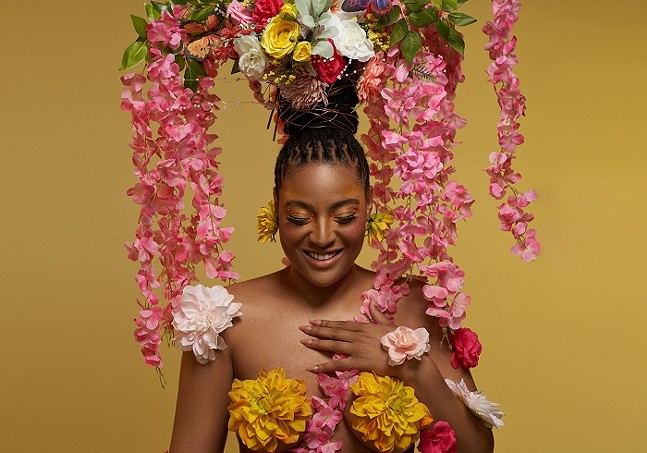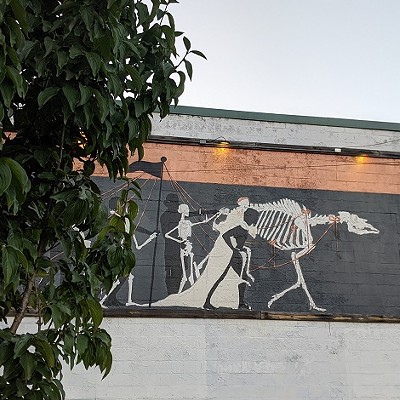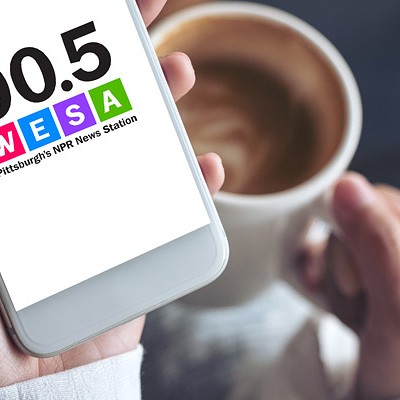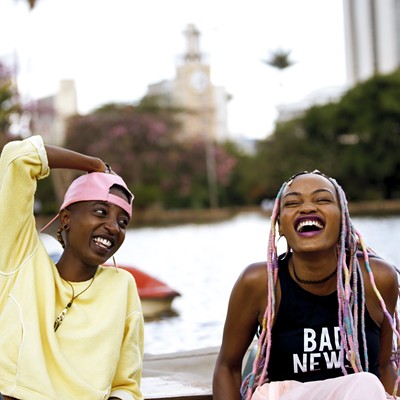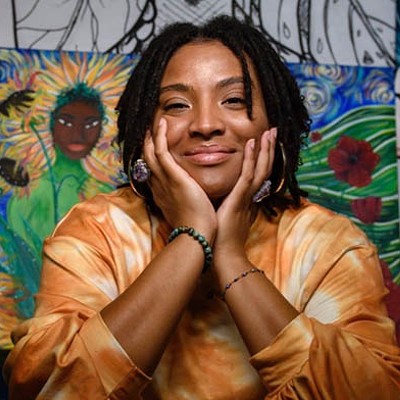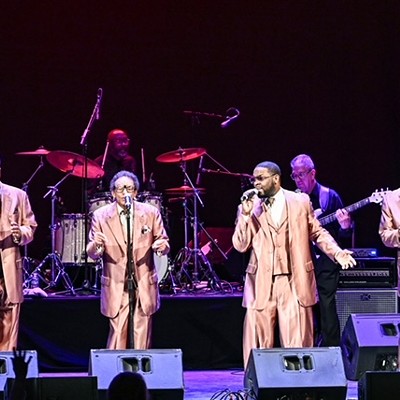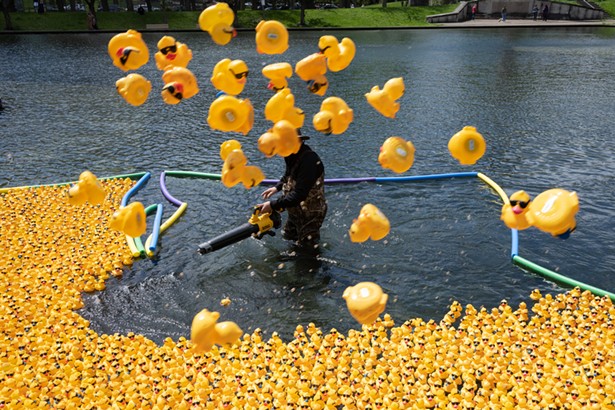Clara Kent taps into Indigenous heritage with The Four Winds music project
Clara Kent guarantees that the next time you see her perform, it will be a completely different experience from the past five years.
“I’m talking about the instrumentation, the arrangement, the step-up of the stage, even my presentation physically. I really want to embody fully the truest part of who I am,” Kent tells Pittsburgh City Paper a few days after celebrating her birthday and before releasing the first installment of her latest project The Four Winds, a four-part EP based on the Indigenous Medical Wheel, or Scared Hoop.
Not that she hasn’t been her most authentic self in recent years, but behind the scenes, Kent has been dealing with costly health issues. She was busy just surviving.
“Now I’m in a space of living,” Kent said. “That’s what I want to embody on stage. Things are going to pop up in life that challenge you, but being able to know that you’ll be OK is a different type of confidence I haven’t had.”
East, the first EP from The Four Winds project, dropped on Juneteenth. It provides a peek into Kent’s growth as an artist and human being over recent years.
She used the forthcoming series as a musical tribute to her transformation and also a love letter for Black and Indigenous Womxn.
City Paper spoke with Kent about the EP and the changes and projects her life has seen in the last several years, like launching her production company, Bounce House Studios & Productions, and her new radio show More Bounce with Clara Kent at WYEP.
This interview has been edited for length and clarity.
When did you start working on The Four Winds? What is the inspiration behind the project?
The Fours Winds is based on a Native American concept — I have heritage in Oglala Lakota, a South Dakota tribe. The concept is about the medicine wheel, which is a tool and, a sacred tool, used in Native American tradition. It has four quadrants, each representing a different season, a different diffraction, a different animal, mortality… so infancy to teenagehood, adulthood, and elder. So it’s pretty layered.
I always wanted to come out with a series around the Medicine Wheel and the Red Road, which is basically choosing a higher path or a path of spirituality regardless of temptation. I always wanted to do something with that concept while also personally going through a phase of transformation and trying out different sounds and music.
I have been working on this even before I did the A U R A mixtape. Some of the songs on the A U R A mixtape were supposed to be a part of this project. Because I went on this path, perfectly, I started to go through different seasons of life and different lessons of what the Red Road would teach me. And it took all the way until now, from 2015 when I first started to play with the idea, to finally be able to implement and manifest it today.
You’ve had a lot of other musical endeavors emerge during that journey — like WYEP, Bounce House Productions, etc. Can you talk a little about the different avenues you’ve been digging into the past few years?
I’ve always wanted to be like a walking festival. I think one of my biggest influences around that concept of being a person that is a walking celebration is watching The Wix and Emerald City. There were certain characters that were full of celebration and joy and they’re funny and they’re silly but they’re also very wise. People with spirits like that inspire me very much. My mother was like that; she was very communal and multifaceted. That’s something I admired as I began to age and grow up.
I’ve wanted to do a production company since I was. like, 11 years old. I still have little papers from then of my dream production company. I want to create freely and I want to collaborate with people that align with similar values that I hold very dear. It’s very interesting to see how things you hold close to your chest, how they naturally happen and unfold.
That’s what’s been happening for the past seven years. I thought I was just creating at first. I didn’t think of the terms "curator" or "creative director," I just liked to throw events, and I just liked it to feel like a festival; that’s my core. It’s not forced; it’s a safe, celebratory space. And people are able to feel nourished in that space. And so I can create, too, and have an actual community. That’s what’s been unfolding in the past seven years, and it’s been amazing to see. I feel very grateful.
How did you get connected to WYEP and what has it been like working with them?
At the time, I already had a relationship with WYEP. They were one of the first places to play my record on the radio and feature my stuff. They had me play at the [WYEP Summer Music Festival]; I got to open for Cautious Clay. I had no idea they had an opening until my friend sent it to me and said, "Hey, didn’t you go to school for radio? You should apply.” I went through a very serious interview process. It was not like, “Oh you have it.” They were very serious about the role.
And after I got the job, I really took the time to make sure the show was going to honor the African diaspora of music. I wanted to highlight artists from all over the world but also show how similar we are, how different we are, and how a lot of popular music in America wouldn’t be the popular music it was if it wasn’t for Black artists of all backgrounds.
So that’s really what More Bounce is; it’s about celebration. Often, being a Black person or an Ingenious person, we have to talk about the trauma in our lives to get noticed. When we talk about the things we enjoy, it’s not as highlighted. I really want to change that. That’s a revolution in itself, to just enjoy life as a Black person and just celebrate the things that you’ve accomplished instead of being like, “OK, I gotta go to the next thing.”
That’s what I was doing for the first five years of my career. I was constantly chasing accolades to build a value that I didn’t know I had. The show every Friday helps remind me of that, and that’s what I want to bring into Pittsburgh, especially for Black artists.
Let’s talk a little more about the EP. Your list of collaborators is amazing, like Winston Bell, Virgil Richmond, Stephen Shriane, and Brandon Lehman. How did you come to work with all these people?
I reached a point where I wanted to further my development and push my voice more, but the only way I could really do that was one, find people I could trust, two, find people that are encouraging, enriching, and motivating, and three, they don’t have an ego in the way. They choose to honor the music first. After going through, like, "studio dating" for a little bit, I finally came across [For The Record Studios in Downtown Pittsburgh].
At first, I was like, I just want to do a mixtape, I just want to have fun, et cetera, et cetera. I played them my demos, and they were like, “These are not mixtape songs.” We were able to take the demos I made and craft them and rearrange them into something phenomenal. They really helped pushed me further and have fun and open up in a different way. I thought I had to be super serious if I was to do an album-type project, but it showed me, no, you still take that fun element you had in the mixtape and put it into the album. When you work with a team, it makes you a fuller person.
“I’m talking about the instrumentation, the arrangement, the step-up of the stage, even my presentation physically. I really want to embody fully the truest part of who I am,” Kent tells Pittsburgh City Paper a few days after celebrating her birthday and before releasing the first installment of her latest project The Four Winds, a four-part EP based on the Indigenous Medical Wheel, or Scared Hoop.
Not that she hasn’t been her most authentic self in recent years, but behind the scenes, Kent has been dealing with costly health issues. She was busy just surviving.
“Now I’m in a space of living,” Kent said. “That’s what I want to embody on stage. Things are going to pop up in life that challenge you, but being able to know that you’ll be OK is a different type of confidence I haven’t had.”
East, the first EP from The Four Winds project, dropped on Juneteenth. It provides a peek into Kent’s growth as an artist and human being over recent years.
She used the forthcoming series as a musical tribute to her transformation and also a love letter for Black and Indigenous Womxn.
City Paper spoke with Kent about the EP and the changes and projects her life has seen in the last several years, like launching her production company, Bounce House Studios & Productions, and her new radio show More Bounce with Clara Kent at WYEP.
This interview has been edited for length and clarity.
When did you start working on The Four Winds? What is the inspiration behind the project?
The Fours Winds is based on a Native American concept — I have heritage in Oglala Lakota, a South Dakota tribe. The concept is about the medicine wheel, which is a tool and, a sacred tool, used in Native American tradition. It has four quadrants, each representing a different season, a different diffraction, a different animal, mortality… so infancy to teenagehood, adulthood, and elder. So it’s pretty layered.
I always wanted to come out with a series around the Medicine Wheel and the Red Road, which is basically choosing a higher path or a path of spirituality regardless of temptation. I always wanted to do something with that concept while also personally going through a phase of transformation and trying out different sounds and music.
I have been working on this even before I did the A U R A mixtape. Some of the songs on the A U R A mixtape were supposed to be a part of this project. Because I went on this path, perfectly, I started to go through different seasons of life and different lessons of what the Red Road would teach me. And it took all the way until now, from 2015 when I first started to play with the idea, to finally be able to implement and manifest it today.
You’ve had a lot of other musical endeavors emerge during that journey — like WYEP, Bounce House Productions, etc. Can you talk a little about the different avenues you’ve been digging into the past few years?
I’ve always wanted to be like a walking festival. I think one of my biggest influences around that concept of being a person that is a walking celebration is watching The Wix and Emerald City. There were certain characters that were full of celebration and joy and they’re funny and they’re silly but they’re also very wise. People with spirits like that inspire me very much. My mother was like that; she was very communal and multifaceted. That’s something I admired as I began to age and grow up.
I’ve wanted to do a production company since I was. like, 11 years old. I still have little papers from then of my dream production company. I want to create freely and I want to collaborate with people that align with similar values that I hold very dear. It’s very interesting to see how things you hold close to your chest, how they naturally happen and unfold.
That’s what’s been happening for the past seven years. I thought I was just creating at first. I didn’t think of the terms "curator" or "creative director," I just liked to throw events, and I just liked it to feel like a festival; that’s my core. It’s not forced; it’s a safe, celebratory space. And people are able to feel nourished in that space. And so I can create, too, and have an actual community. That’s what’s been unfolding in the past seven years, and it’s been amazing to see. I feel very grateful.
How did you get connected to WYEP and what has it been like working with them?
At the time, I already had a relationship with WYEP. They were one of the first places to play my record on the radio and feature my stuff. They had me play at the [WYEP Summer Music Festival]; I got to open for Cautious Clay. I had no idea they had an opening until my friend sent it to me and said, "Hey, didn’t you go to school for radio? You should apply.” I went through a very serious interview process. It was not like, “Oh you have it.” They were very serious about the role.
And after I got the job, I really took the time to make sure the show was going to honor the African diaspora of music. I wanted to highlight artists from all over the world but also show how similar we are, how different we are, and how a lot of popular music in America wouldn’t be the popular music it was if it wasn’t for Black artists of all backgrounds.
So that’s really what More Bounce is; it’s about celebration. Often, being a Black person or an Ingenious person, we have to talk about the trauma in our lives to get noticed. When we talk about the things we enjoy, it’s not as highlighted. I really want to change that. That’s a revolution in itself, to just enjoy life as a Black person and just celebrate the things that you’ve accomplished instead of being like, “OK, I gotta go to the next thing.”
That’s what I was doing for the first five years of my career. I was constantly chasing accolades to build a value that I didn’t know I had. The show every Friday helps remind me of that, and that’s what I want to bring into Pittsburgh, especially for Black artists.
Let’s talk a little more about the EP. Your list of collaborators is amazing, like Winston Bell, Virgil Richmond, Stephen Shriane, and Brandon Lehman. How did you come to work with all these people?
I reached a point where I wanted to further my development and push my voice more, but the only way I could really do that was one, find people I could trust, two, find people that are encouraging, enriching, and motivating, and three, they don’t have an ego in the way. They choose to honor the music first. After going through, like, "studio dating" for a little bit, I finally came across [For The Record Studios in Downtown Pittsburgh].
At first, I was like, I just want to do a mixtape, I just want to have fun, et cetera, et cetera. I played them my demos, and they were like, “These are not mixtape songs.” We were able to take the demos I made and craft them and rearrange them into something phenomenal. They really helped pushed me further and have fun and open up in a different way. I thought I had to be super serious if I was to do an album-type project, but it showed me, no, you still take that fun element you had in the mixtape and put it into the album. When you work with a team, it makes you a fuller person.

